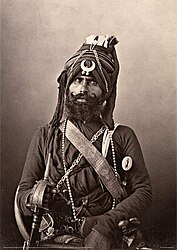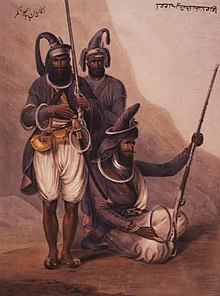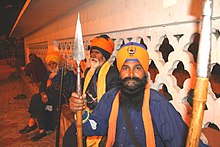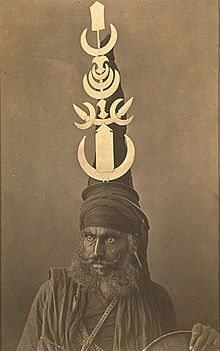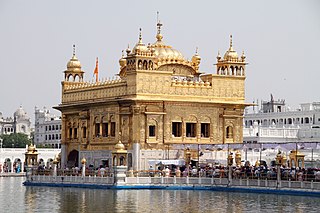
Sikhism, also known as Sikhi, is an Indian religion and philosophy in particular for the Sikh ethnoreligious group that originated in the Punjab region of India around the end of the 15th century CE. The Sikh scriptures are written in the Gurumukhi script particular to Sikhs. It is one of the most recently founded major religious groups and among the largest in the world, with about 25–30 million adherents.

Guru Gobind Singh was the tenth and last human Sikh Guru. He was a warrior, poet, and philosopher. In 1675, at the age of nine he was formally installed as the leader of the Sikhs after his father Guru Tegh Bahadur was executed by Emperor Aurangzeb. His father was the ninth Sikh Guru. His four biological sons died during his lifetime – two in battle and two executed by the Mughal governor Wazir Khan.

The Guru Granth Sahib is the central holy religious scripture of Sikhism, regarded by Sikhs as the final, sovereign and eternal Guru following the lineage of the ten human gurus of the religion. The Adi Granth, its first rendition, was compiled by the fifth guru, Guru Arjan (1564–1606). Its compilation was completed on 29 August 1604 and first installed inside the Golden Temple in Amritsar on 1 September 1604. Baba Buddha was appointed the first Granthi of the Golden Temple. Shortly afterwards Guru Hargobind added Ramkali Ki Vaar. Later, Guru Gobind Singh, the tenth Sikh guru, added hymns of Guru Tegh Bahadur to the Adi Granth and affirmed the text as his successor. This second rendition became known as the Guru Granth Sahib and is also sometimes referred to as the Adi Granth.

Khalsa refers to both a community that considers Sikhism as its faith, as well as a special group of initiated Sikhs. The Khalsa tradition was initiated in 1699 by the Tenth Guru of Sikhism, Guru Gobind Singh. Its formation was a key event in the history of Sikhism. The founding of Khalsa is celebrated by Sikhs during the festival of Vaisakhi.
Adherents of Sikhism follow a number of prohibitions. As with any followers of any faith or group, adherence varies by each individual.
The following outline is provides an overview of Sikhism, or Sikhi.

The Dasam Granth is a collection of various poetic compositions attributed to Guru Gobind Singh. The text enjoyed an equal status with the Adi Granth, or Guru Granth Sahib, in the eighteenth and nineteenth centuries and were installed side by side on the same platform. The Dasam Granth lost favor during the colonial period when reformist Singh Sabha Movement scholars couldn't contextualize the reworkings of Puranic stories or the vast collection of 'Tales of Deceit' Sri Charitropakhyan.

The Nishan Sahib in Sikhism is a triangular flag made of cotton or silk cloth, with a tassel at its end. The current form of the Nishan Sahib that is in use throughout Gurdwaras around the world has an orange (saffron) background color that has the Khanda symbol in the center of the flag. It is commonly hoisted on a tall flagpole outside Gurdwaras.

The Sarbloh Granth or Sarabloh Granth, also called Manglacharan Puran or Sri Manglacharan Ji, is a voluminous scripture, composed of more than 6,500 poetic stanzas. It is traditionally attributed as being the work of Guru Gobind Singh, the tenth Sikh guru. Scholars, on the other hand, attribute the work to after the Guru's death, being authored by an unknown poet. The work is mostly revered by the Nihang sect.

Fateh Singh, commonly referred to with honorifics as Baba Fateh Singh or Sahibzada Baba Fateh Singh, was the fourth and youngest son of Guru Gobind Singh.

The Sikh Khalsa Army, also known as Khalsaji or simply Sikh Army, was the military force of the Sikh Empire. With its roots in the Khalsa founded by Guru Gobind Singh, the army was later modernised on Franco-British principles by Maharaja Ranjit Singh. It was divided in three wings: the Fauj-i-Khas (elites), Fauj-i-Ain and Fauj-i-Be Qawaid (irregulars). Due to the lifelong efforts of the Maharaja and his European officers, it gradually became a prominent fighting force of Asia. Ranjit Singh changed and improved the training and organisation of his army. He reorganized responsibility and set performance standards in logistical efficiency in troop deployment, manoeuvre, and marksmanship. He reformed the staffing to emphasize steady fire over cavalry and guerrilla warfare, improved the equipment and methods of war. The military system of Ranjit Singh combined the best of both old and new ideas. He strengthened the infantry and the artillery. He paid the members of the standing army from treasury, instead of the Mughal method of paying an army with local feudal levies.
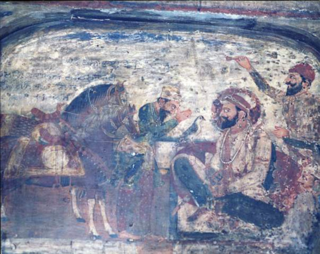
Bidhi ChandChhina was a Sikh religious preacher and military commander, from Chhina Bidhi Chand village, 37 kilometers south of Amritsar and Chhina Bidhi Chand was part of Amritsar District not Lahore. His birth place temple is situated in his own village Chhina Bidhi Chand, which was built by the residents with the help of Baba Daya Singh. Baba Daya Singh laid foundation with his own hands. Every year on his birthday Baba Daya Singh, and now Baba Avtar Singh, would go to village Chhina Bidhi Chand and celebrate it there to date. He was a disciple of Guru Arjan and served Guru Hargobind for most of his life.

The Dumalla is a type of turban worn by Sikhs. This turban is worn mainly by Sikhs who are initiated into the Khalsa, through participating in the Amrit Sanchar but can be worn by all Sikhs. However, the more common one is the Dastar. The word Dumalla means "Du" meaning two and "Malla" meaning cloth or fabric. This is because there will usually be one fabric to form the base of the turban and a second to wrap around the base to form the turban itself. There many different types of Dumalla, in many different sizes and colours.
A takht, or taḵẖat, literally means a throne or seat of authority and is a spiritual and temporal centre of Sikhism. There are five takhts, which are five gurudwaras that have a very special significance for the Sikh community. Three are located in Punjab whilst the remaining two are located outside of it.

Dharam Singh is a Nihang theologian, writer, preacher known for exegesis and expositions of Adi Granth and Dasam Granth. Enrolled as Nihang in Budha Dal, he worked as a secretary and participated in various religious conventions. He contributed the view of Sikh Religion on Human Rights in German Book, Menschenrechte im Weltkontext. In February 2015, he was the very first speaker of the dialogue series entitled Religion Matters established by the German Federal Ministry of Economic Cooperation and Development (BMZ). On letter call from SGPC, he had written various articles in response to Gurbaksh Singh Kala Afghana, who spoke against Amrit and Dasam Granth.

Pashaura Singh (1928–2008) also known as Santa Singh or to Nihang Sikhs as Jathedar Akali Baba Santa Singh Ji Nihang 96 Crori was the 13th Jathedar of Budha Dal, succeeding Akali Chet Singh.

Sikh sects, denominations, traditions, movements, sub-traditions, also known as sampardai in the Punjabi language, are sub-traditions within Sikhism that believe in different approaches to practicing the religion. All sampradas believe in the One Creator God typically rejecting both idol worship and caste systems. Different interpretations have emerged over time, some of which have a living teacher as the leader. The major historic traditions in Sikhism, states Harjot Oberoi, have included Udasi, Nirmala, Nanakpanthi, Khalsa, Sahajdhari, Namdhari Kuka, Nirankari and Sarvaria.
Shastar Vidya, also known as Sanatan Shastar Vidya, is a Sikh martial art form dating back to the 17th century.

The Akal Sena was the Sikh military force established by the sixth Sikh Guru, Guru Hargobind. It was the first standing Sikh army. It was also known as the Akali Dal.

The Sarbat Khalsa of 1986 was one congregation of the Guru Khalsa Panth, including the Damdami Taksal, Akal Takht, Panthic Committee (Manochahal), Panthic Committee (Zaffarwal), Kharku Sikhs, Tarna Dal (Hariabelan), Tarna Dal, Bidhi Chand Dal and the Shiromani Budha Dal.

